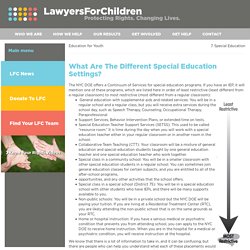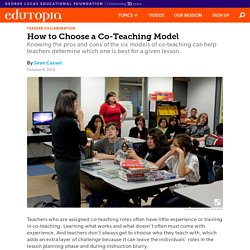

Sec. 300.114 LRE requirements - Individuals with Disabilities Education Act. 300.114 LRE requirements. (1) Except as provided in §300.324(d)(2) (regarding children with disabilities in adult prisons), the State must have in effect policies and procedures to ensure that public agencies in the State meet the LRE requirements of this section and §§300.115 through 300.120. (2) Each public agency must ensure that— (i) To the maximum extent appropriate, children with disabilities, including children in public or private institutions or other care facilities, are educated with children who are nondisabled; and (ii) Special classes, separate schooling, or other removal of children with disabilities from the regular educational environment occurs only if the nature or severity of the disability is such that education in regular classes with the use of supplementary aids and services cannot be achieved satisfactorily.

(b) Additional requirement—State funding mechanism— What Are Least Restrictive Environment, Inclusion and Mainstreaming? When your child’s (IEP) team meets, it talks about many things.

That includes your child’s areas of strength, areas of weakness and present level of performance. The team also talks about the “least restrictive environment,” or LRE, for your child’s education. The word “environment” makes LRE sound like a place. But it actually is more about your child’s educational program. Where your child learns is only one piece of the program. Least Restrictive Environment (LRE) LRE is part of the Individuals with Disabilities Education Act (IDEA).
IDEA says two things about LRE that are important to understand when working with the IEP team: A key word here is “appropriate.” Mainstreaming and Inclusion When LRE comes up, so do the words “mainstreaming” and “inclusion.” A mainstream classroom is a general education classroom. “The intent of LRE is to make sure that kids who receive special education are included in the general education classroom as often as possible.”
What Are The Different Special Education Settings? The NYC DOE offers a Continuum of Services for special education programs.

If you have an IEP, it will mention one of these programs, which are listed here in order of least restrictive (least different from a regular classroom) to most restrictive (most different from a regular classroom): General education with supplemental aids and related services: You will be in a regular school and a regular class, but you will receive extra services during the school day, such as Speech Therapy, Counseling, Occupational Therapy, ParaprofessionalSupport Services, Behavior Intervention Plans, or extended time on tests.Special Education Teacher Support Services (SETSS): This used to be called “resource room.”
10tips.placement. My son has been in special education since pre-school.

Some years, his material was too hard. Other years, he was with students who could not read or write. There was no support for him in the general education classroom. I feel like I must choose between his mental health and academics. The school does not seem to have a good placement for my child. Do Not Put Placement Before the IEP You must have an appropriate IEP before you can get an appropriate placement. IDEA requires all IEPs to include present levels of academic achievement and functional performance. (20 U.S.C. 1414(d)(A)(i)) Start by making a grocery list of your child’s present levels of educational and functional performance.
You can list anything that affects your child’s ability to function inside and outside of the school setting! The IEP is the Blueprint for Your Child’s Program. How to Choose a Co-Teaching Model. 6 Models of Co-Teaching: Pros and Cons One Teaching, One Observing: As a supervisor, I’ve seen this model implemented both with purpose and without.

It takes time to develop a working relationship with another teacher. When the relationship isn’t working, this model appears more often, and often without purpose. When one teacher is directly instructing the students, the other should be observing. The observing teacher is collecting data, which can be useful in determining what instruction takes place next, which students need additional help, and what co-teaching model may be used next to address any identified needs. Pros: less time collaborating, less interruption, more focused and purposeful data collection. Cons: loss of one instructor, can be used too often due to a lack of planning or a lack of content knowledge or self-efficacy, can be underutilized for its intended purpose without focused data collection. Co Teaching Visual. Push In vs Pull Out in Special Education.
Kids With Learning Disabilities. If your child’s services aren’t meeting her needs, what can you do?

One option might be an out-of-district . With this option, your district would pay for your child to attend an outside school that offers the type of help and setting she needs. It could be a public school, a private day school or a residential school where she lives full time. This isn’t something you can just choose for your child, unless you’re prepared to pay the tuition yourself.